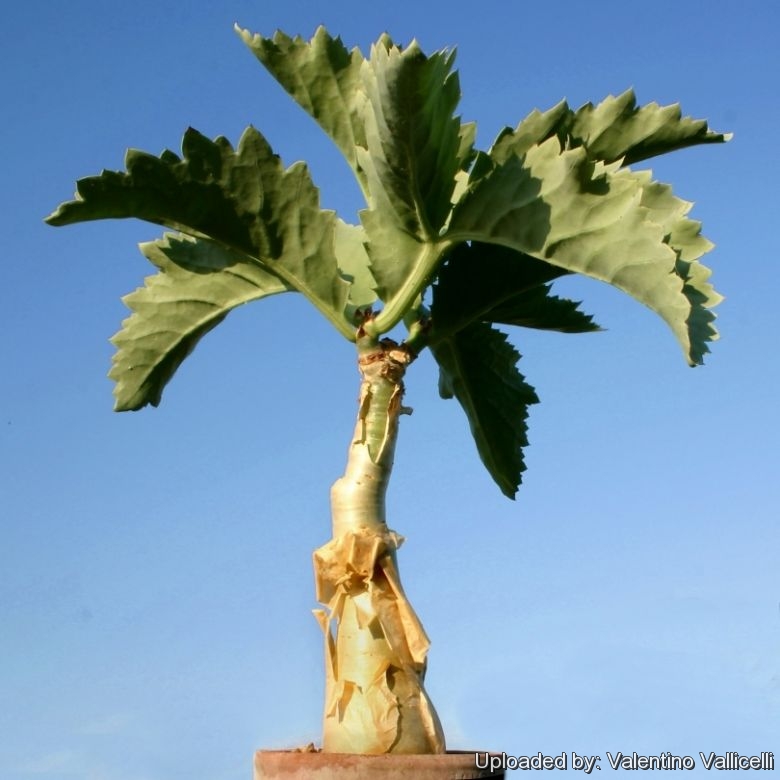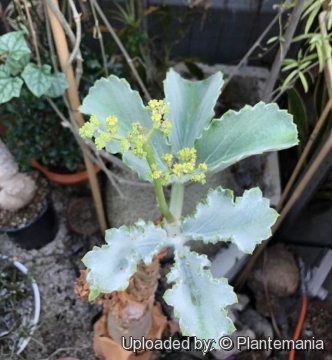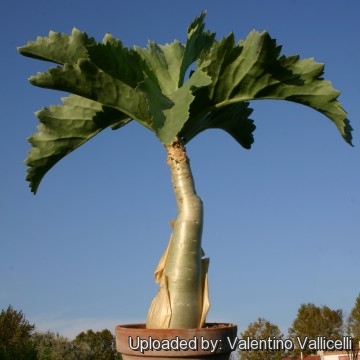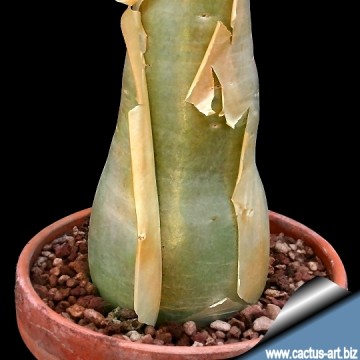Accepted Scientific Name: Cyphostemma bainesii (Hook.f.) Desc.
Naturalia Monspel., Sér. Bot. 18: 218, basionymo cit. 1967 [See also: Notul. Syst. (Paris) 16: 120. 1960 ]

Vitis bainesii (Cyphostemma bainesii) Photo by: Valentino Vallicelli
It has a bottle shaped caudex with a very ornamental papery yellowish and smooth bark that peels in rings to reveal grey-green.
Origin and Habitat: Central western Namibia and South Africa
Habitat: Grows in dry rocky outcrops in a well drained soil with some water usually at the base of boulders where it receives a bit of shade from the burning sun.
Synonyms:
Common Names include:
ENGLISH: Butterwood Tree, Gouty Vine, African Tree Grape
Description: It a deciduous succulent shrub or small tree that grows up to 1,5 (5)m high with thick or bottle shaped trunks (caudex) up to 40 cm wide. It is very similar to C. juttae, but shorter and fatter. Bark is papery and smooth, very attractive, clear yellowish-brown to pastel and peeling in rings to reveal grey-green.
Leaves: Huge, bright yellowish-green to glaucous green often with red undulated margins covered with a fairly dense fuzz.
Flowers: In a lose inflorescence on mature plants and are followed by ornamental, orange grapes (don't eat them they are high in tannic acid and not sweet) they may be slightly toxic.
Bibliography: Major references and further lectures
1)Umberto Quattrocchi “CRC World Dictionary of Medicinal and Poisonous Plants: Common Names, Scientific Names, Eponyms, Synonyms, and Etymology” (5 Volume Set) CRC Press, 03/May/2012
2) Gordon Rowley “Caudiciform and Pachycaul Succulents: Pachycauls, Bottle-,Barrel-And Elephant-Trees and Their Kin a Collector's Miscellany” Strawberry Press. June 1st 1987
3) Werner Rauh “The Wonderful World of Succulents: Cultivation and Description of Selected Succulent Plants Other Than Cacti” Smithsonian Institution Press, 1984
 Vitis bainesii (Cyphostemma bainesii) Photo by: Cactus Art
Vitis bainesii (Cyphostemma bainesii) Photo by: Cactus Art Vitis bainesii (Cyphostemma bainesii) Photo by: © Plantemania
Vitis bainesii (Cyphostemma bainesii) Photo by: © Plantemania - It has a bottle shaped caudex with a very ornamental papery yellowish and smooth bark that peels in rings to reveal grey-green. (Cyphostemma bainesii) Photo by: Valentino Vallicelli
- It has a bottle shaped caudex with a very ornamental papery yellowish and smooth bark that peels in rings to reveal grey-green. (Cyphostemma bainesii) Photo by: Valentino Vallicelli Vitis bainesii (Cyphostemma bainesii) Photo by: Cactus Art
Vitis bainesii (Cyphostemma bainesii) Photo by: Cactus ArtCultivation and Propagation: Cyphostemma bainesiiSN|11033]]SN|11033]] is easy to grow, does well in the ground, and makes an impressive specimens, though fairly slow growing. It is also suited to greenhouse culture but do well out of doors in Mediterranean climate. It doesn't like the wet winter but will survive.
Soil: A fast-draining rich, well drained cactus mix should be used when potting. Outdoor plant it in a loamy or sandy soil where drainage is optimal.
Watering: It is drought tolerant, but it appreciates plentifully of water and some fertilizer during the summer growing season, but keep dry in winter in order to prevent rotting. As with all succulents one must be careful not to over-water. These plants can survive with very little water and too often plants die as a result of too much water. Despite coming from areas that are dry in winter, it can adapt to wet-winter areas like coastal California. If one lives in a very wet area, it is best to rather keep plants in big containers where they can be easily moved to a sheltered place.
Exposure: It like lots of sun throughout the year.
Hardiness: Mature plants are hardy to -3° C (or less), but it is best to avoid freezing temperatures especially if the plants are young. Cyphostemma comes from the hot, dry areas of southern Africa, so it has no problem taking temperatures up to 40° C; however, it may need some afternoon shade in hot climates to avoid leaf burn.
Garden uses: Cyphostemma are very sought-after plants for the garden, as are other caudiciform plants such as baobabs, adeniums and tylecodons. They make superb container or open garden subjects in and around the garden, especially around swimming pools and courtyards. They are ideal accent plants for a rockery, or may be planted in a large container on a sunny protected patio.
Propagation: Propagate usually from seed that must be prepared, aged and scarified and even then germination is uncertain or by cuttings. Plant seeds in winter 1-2 cm deep in moist, sterile soil. Keep soil temperature consistent at 20-30° C, with some day/variation in this range. Cool soils will significantly delay seed germination time if not inhibit germination altogether. Because seeds need a very long time for germination, take care to use sterile soil, do not re-use soil that was used for other plantings. It is also recommended seeds be germinated in a high humidity environment so constant watering is not necessary. Either germinate seeds in a greenhouse or make a temporary "greenhouse" by covering containers with plastic wrap, or by putting containers inside a ziplock bag. Monitor for fungal growth and air out if/when necessary. Germination tends to be slow and erratic. 6-12 months, sometimes up to 24 months. Propagation can also be undertaken by means of cuttings. Cuttings or truncheons can be made in coarse river sand. Again it is important to water with caution especially when cuttings have rooted.
Warning: The grape-like berries are very dcorative but unlike the edible grape they are poisonous.














